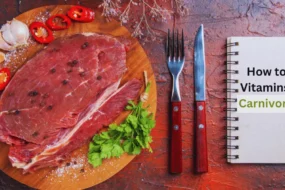- Home
- Weight Loss
- Can I Lose Weight on a Carnivo ...

The carnivore diet, which consists entirely of meat and animal products, is often claimed to be a powerful way to transform health and achieve weight loss. However, it’s extremely restrictive, eliminates essential nutrients like fiber and vitamin C, and is difficult to maintain long-term.
While its benefits are often obvious, such as shedding pounds, it is important to note that success varies, and the diet may not work for everyone.
Can I Lose Weight on a Carnivore Diet?
Yes, the carnivore diet can help with weight loss by boosting fat burn and curbing hunger, but its success depends on individual responses and commitment to its strict regimen.
What is the Carnivore Diet?
The carnivore diet is a unique approach where you cut carbohydrates completely and focus only on eating meat and animal products like beef, chicken, pork, fish, and eggs. By cutting carbs, the body begins to burn fat for energy, which can help you lose weight.
Proponents claim that it can fight inflammation, lower blood sugar, especially for those with diabetes, and even improve mental health. Unlike the ketogenic or Atkins diets, which only limit carbs, the carnivore diet eliminates all food groups such as fruits, vegetables, grains, nuts, seeds, and legumes.
Interestingly, a carb-free lifestyle isn’t new. In the late 1700s, Scottish military surgeon John Rollo, MD, used a meat-only diet to treat patients with diabetes, helping them control their blood sugar levels.
While the method has evolved, the idea of relying on fat and protein to fuel the body remains a key principle. This diet may not be for everyone, but it continues to intrigue those seeking rapid weight loss and better health outcomes.
How Does the Carnivore Diet Work?
The Carnivore Diet focuses on eating only animal-based foods like red meat, fish, and eggs, while completely cutting out carbohydrates. When you eat carbs, your body turns them into sugar or glucose, which provides your main energy source.
However, by eliminating these inflammatory foods such as pasta, French fries, and doughnuts, your body is forced to switch its energy system. Without glucose from carbs, the body converts fat into energy, producing ketones. This metabolic shift can speed up fat burning and help with weight loss.
Interestingly, people often report that they won’t feel hungry on this diet because protein and fat keep them full longer. While some claim it helps improve blood sugar control for those with type 2 diabetes, it’s important to note that not everyone responds the same way.
Some may thrive, while others struggle with energy levels. Whether following the Carnivore Diet or exploring options like the Metaboost Diet Plan PDF, it’s essential to understand that dietary success depends on individual needs and responses.
How Do I Start the Carnivore Diet?
Starting the carnivore diet might feel overwhelming at first, but with a few simple steps, you’ll be ready to dive in. The key is prep and grocery shopping. First, clear out your pantry and refrigerator of anything that contains carbs—this helps reduce the temptation to veer off track. Make a list of important items and stick to it. Your primary focus should be on meat, poultry, and seafood.
The simplicity of shopping in just a few sections of the store not only saves time but also keeps you committed to your goals. This straightforward approach makes it easier to lose weight while sticking to a diet that eliminates distractions from unnecessary foods.
You’ll find that reducing the mental work of meal decisions helps maintain momentum and stay motivated throughout the process.
Carnivore Diet Foods

Foods Allowed on the Carnivore Diet
If you’re wondering what you can eat on a carnivore diet, the answer is simple: only animal products. This means your meals revolve around meat like beef, chicken, turkey, lamb, and pork, or even organ meats such as liver, kidney, heart, tripe, and brain.
You can also enjoy a variety of fish like salmon, mackerel, sardines, tilapia, crab, lobster, and herring. Don’t forget eggs, lard, and bone marrow to add some richness to your diet. While dairy isn’t the focus, small amounts of heavy cream, cheese, or butter can be included.
Hydration comes from water, and for seasoning, salt, pepper, and carb-free seasonings are typically allowed. Some people add yogurt, milk, or soft cheese, but these are usually avoided due to their carb content. The idea is to simplify food choices, making it easier to stick to your plan and focus on your weight loss journey.
Foods to Avoid on the Carnivore Diet
To succeed on a strict carnivore diet, it’s crucial to eliminate all plant-based foods and other non-animal products. Here’s a breakdown of what to avoid:
- Vegetables: Broccoli, cauliflower, potatoes, green beans, peppers
- Fruits: Apples, berries, bananas, kiwi, oranges
- Nuts and seeds: Almonds, pumpkin seeds, pistachios
- Grains: Rice, wheat, bread, quinoa, pasta
- High-lactose dairy: Milk, yogurt, soft cheese
- Legumes: Beans, lentils
- Alcohol: Beer, wine, liquor
- Beverages: Soda, coffee, tea, fruit juice
- Sugars: Table sugar, maple syrup, brown sugar
By avoiding these foods, you stay focused on animal-based eating, which may promote fat loss and support your weight-loss goals.
Pros and Cons of the Carnivore Diet
Pros of the Carnivore Diet
- The carnivore diet eliminates carbs, including cookies, cakes, sodas, and other high-carb foods.
- It cuts out high-calorie, low-nutrient items, which may lead to early benefits like reduced belly fat, improved blood pressure, and better cardiovascular health.
- Avoiding high-sugar foods can help control blood sugar levels, which is helpful for people with diabetes.
- The complete elimination of refined carbs often leads to better health outcomes, though lasting effects are still uncertain due to limited research.
- While removing carbs entirely is not always necessary, eating smaller amounts of wholesome, high-fiber carbs can aid in diabetes management and overall well-being.
Cons of the Carnivore Diet
The carnivore diet contradicts the Dietary Guidelines for Americans, which suggest that adults should obtain 45% to 65% of their daily calories from carbohydrates. By cutting out entire food groups, this diet may leave you short on important nutrients like vitamins and minerals.
Vegetables, for example, provide essential sources of fiber, potassium, and vitamins A and C, as well as folate. Eliminating these foods can create gaps in your nutrition, potentially impacting long-term health.
FAQ’s
Q: Do You Lose Weight Fast on a Carnivore Diet?
Yes, the carnivore diet can result in rapid weight loss by boosting protein consumption, lowering calorie intake, and encouraging the loss of water weight.
Q: How Much Should I Eat on the Carnivore Diet to Lose Weight?
To lose weight on the carnivore diet, most adults should aim for a calorie intake between 1,500-3,000 per day, depending on their metabolism and activity levels. Protein should make up 60-80% of your total calories, while fat should contribute the remaining 20-40% to help keep you full and support fat burning.
Q: How Long Does It Take to See Results from The Carnivore Diet?
Many notice weight loss and improved fat burn within 3-6 weeks of starting the carnivore diet, as the body adapts to using fat for energy. Some feel their energy rise quickly, while visible changes in weight and body composition become apparent by this mark.
Conclusion
The carnivore diet offers a unique approach to weight loss, focusing on high-protein, low-carb meals that help the body shift to burning fat for energy. While many see rapid results like improved fat burn, reduced hunger, and weight loss, the diet’s restrictive nature and lack of essential nutrients require careful consideration.
Whether you’re seeking a way to shed pounds or explore its potential health benefits, the carnivore diet can be effective for some but may not suit everyone. Always consult a healthcare professional before making significant dietary changes to ensure it aligns with your individual needs and long-term goals.
I’m Ayesha Zahid, a certified Nutritionist and Dietitian with over 3 years of hands-on experience helping individuals and families improve their health through nutrition.






